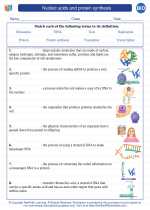Nucleic Acids and Protein Synthesis
Nucleic Acids
Nucleic acids are macromolecules that store and transmit genetic information. There are two main types of nucleic acids: DNA (deoxyribonucleic acid) and RNA (ribonucleic acid).
DNA Structure
DNA is composed of two strands that are twisted into a double helix. Each strand is made up of nucleotides, which consist of a sugar (deoxyribose), a phosphate group, and a nitrogenous base (adenine, thymine, cytosine, or guanine).
RNA Structure
RNA is a single-stranded molecule that is similar in structure to DNA, but it contains the sugar ribose and the nitrogenous base uracil instead of thymine.
Protein Synthesis
Protein synthesis is the process by which cells build proteins. It involves two main steps: transcription and translation.
Transcription
During transcription, the DNA sequence of a gene is copied into a complementary RNA sequence. This process occurs in the nucleus of eukaryotic cells and in the cytoplasm of prokaryotic cells. The enzyme RNA polymerase catalyzes the formation of the RNA molecule.
Translation
Translation is the process by which the RNA sequence is used to assemble a chain of amino acids to form a protein. This process takes place in the ribosomes of the cell. Transfer RNA (tRNA) molecules bring the appropriate amino acids to the ribosome, where they are joined together to form a polypeptide chain.
Study Guide
- What are the two main types of nucleic acids?
- Describe the structure of DNA.
- How does RNA differ from DNA in terms of structure?
- What is the process of transcription and where does it occur?
- Explain the process of translation and where it takes place.
- What is the role of tRNA in protein synthesis?
◂Biology Worksheets and Study Guides High School. Nucleic acids and protein synthesis
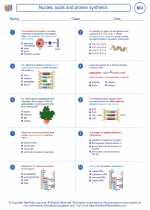
 Worksheet/Answer key
Worksheet/Answer key
 Worksheet/Answer key
Worksheet/Answer key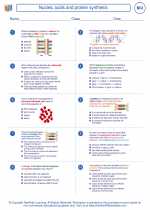
 Worksheet/Answer key
Worksheet/Answer key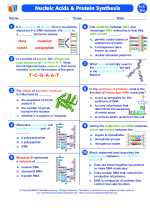
 Vocabulary/Answer key
Vocabulary/Answer key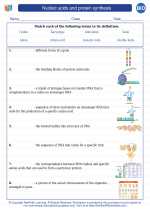
 Vocabulary/Answer key
Vocabulary/Answer key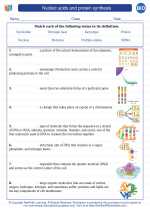
 Vocabulary/Answer key
Vocabulary/Answer key